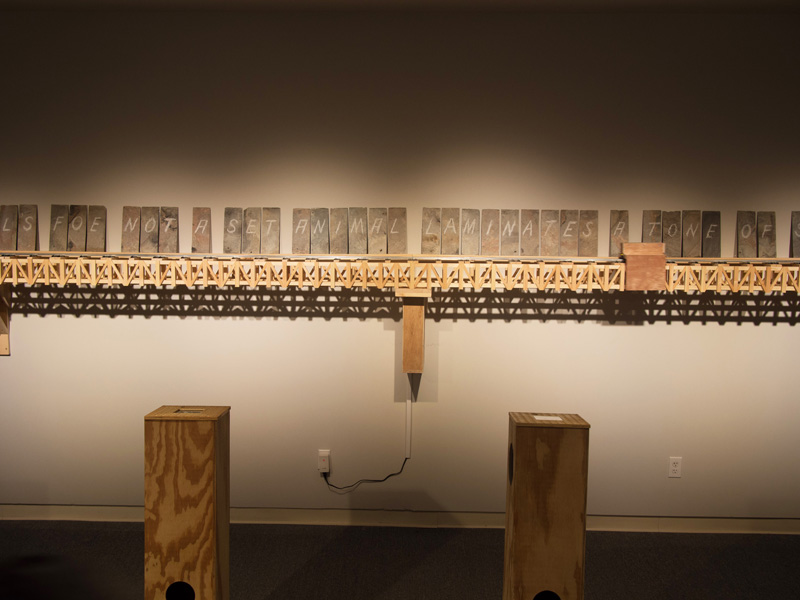Varied use of mediums in Pestel’s Requiem exhibit
Photo by Willem Ytsma ‘16
Artist and musician Michael Pestel explores themes of extinction and destruction in his exhibition “Requiem, Ectopistes migratorius” at the Williams Center Gallery. The exhibit will run through the semester, closing on December 13, 2014.
Extopistes migratorius, more commonly known as the Passenger Pigeon, is a formerly omnipresent species and Pestel’s inspiration. This year marks the centenary of the pigeons’ extinction, which has been largely attributed to hunting and the destruction of habitats. “Requiem” is a part of Project Passenger Pigeon, an ongoing, nationwide attempt to reconcile and learn from one of the world’s most dramatic extinctions.
As Director of Art Galleries Michiko Okaya pointed out in her introduction of Pestel, the Passenger Pigeon is the first species in which humans have been able to pinpoint the exact moment of extinction. The opening of “Requiem” is the first of several events at Lafayette related to Project Passenger Pigeon. On November 19, a performance of “Stray Birds” will be held. Pestel will also be on campus throughout the fall as an artist-in-residence.
In a talk at the Williams Center on Wednesday, September 17, Pestel remarked that he hoped his exhibit would help students question their relationship with nature.
To that end, Pastel incorporates a variety of mediums to emphasize the fleeting existence of the Passenger Pigeon, and ultimately, humanity’s role in its disappearance. Upon first glance, the new exhibition at the Williams Center Gallery seems devoid of natural characteristics. One notable piece is a massive, industrial, wooden structure. Upon closer examination, the structure is a bird-cage, with Martha (the last pigeon) in the center. Images of birds are incorporated into the installation.
Pastel also explained that some of the objects found in the exhibit, such as pieces of chalk, actually replicate the sounds of birds found in nature. Juxtaposing different elements, ranging from the manmade bird cage to acorns and bird sounds, Pastel highlights the consequences of humanity’s interactions with the birds and their habitat.
While the exhibit was thought provoking, the overall experience felt claustrophobic due to the venue. Limited in space, the Williams Center Gallery requires the pieces to be closely grouped together. From certain angles, it was difficult to take in the largest installation, the Bird Cage. A highlight of the exhibition was the bizarre contraption containing the tools of destruction of the species. Despite this fact, Pastel seamlessly meshes them together to create a device that almost seems natural. In turn, the piece provides insights into the events throughout modern history that lead to the extinction.
One of the more impressive features of the exhibition is Pastel’s attention toward the means through which the Pigeon became extinct. Pastel includes a locomotive, telegraph, and gun in one piece; effectively representing three technological advances that contributed to the extinction. It was also fascinating to see the various ways Pastel told the story of the Passenger Pigeon. Traditional images, audio, sounds, and larger installations are intertwined to present a compelling narrative of the end of a species. Raising important social questions, “Requiem” is worth the trek down the hill to the Williams Center Gallery.


























































































































Michiko Okaya • Sep 19, 2014 at 2:55 pm
Thanks very much for writing about the Requiem: Ectopistes migratorus exhibition. A note of clarification, the Williams Center Gallery is located in the Williams Center for the Arts on main campus. The Grossman Gallery is in the Williams Visual Arts Building downtown.
Additional information about the exhibition and related programs can be found at http://galleries.lafayette.edu/category/passenger-pigeon-centennial/